Effective retinoic peeling at home is possible, and this is evidenced by numerous reviews of women who practice this procedure on their own. But thinking that it is very easy to do is a mistake. You need to know a number of nuances to get the expected result.
If you have already decided to carry out cosmetic manipulations at home, let's study all the intricacies of the process. And let's start with the “basics”.
Principle of action and effectiveness of retinoic peeling
First of all, let's clarify the terminology. Yellow peeling is called retinol and retinoic. Many (even experts) equate these two procedures. Meanwhile, they have some differences. So, retinol peeling involves the use of vitamin A. Retinoic peeling is the treatment of the skin with retinoic acid, which contains retinoids - artificial substitutes for vitamin A.
The first option is softer and does not have such an aggressive effect on the epidermis. But at the same time, it is less effective in the presence of serious problems.
The second option can be classified as superficial-median procedures. Therefore, the impact is somewhat more powerful. However, such manipulation requires more careful preparation and longer recovery.
The principle of action of retinoic peeling is as follows: the active components, coming into contact with the skin, penetrate into the epidermal tissues. They regulate processes in cells and intercellular spaces, stimulating the production of collagen and elastin, and have an exfoliating effect.
Yellow peeling at home can do the following:
- removing a layer of keratinized cells from the surface;
- improvement of oxygen metabolism, nutrient absorption;
- stimulation of the production of protein compounds responsible for the condition of the skin;
- activation of regenerative processes;
- comprehensive improvement of the epidermis;
- normalization of blood microcirculation;
- strengthening local immunity;
- improving skin hydration;
- lifting effect;
- alignment of microrelief and skin tone;
- removal of hyperpigmentation;
- prevention of inflammatory processes, acne, pimples, blackheads, comedones;
- prevention of skin cancer.
Before moving on to the question of how to do yellow peeling at home, let’s pay attention to the indications and contraindications.
Indications for use
Retinol peeling at home It is recommended for women aged 30-35 years. Cosmetologists say that there is no point in doing such a procedure for younger ladies without good reason. This is too aggressive for their skin.
Direct indications for peeling with retinol include the following conditions and defects of the epidermis:
- signs of photo and chronoaging;
- facial wrinkles and skin folds;
- loss of elasticity, sagging, sagging;
- change in the structure of the oval of the face;
- acne, comedones, sebaceous plugs, pimples, milliums;
- increased oily or dry skin;
- hyperkeratosis and keratomas;
- hyperpigmentation;
- scars, scars, post-acne.
Peeling with vitamin A or its derivatives at home will help to effectively cope with the above problems.
Manufacturers of cosmetics in the description of preparations for self-retinoic peeling indicate all the precautions that must be strictly observed.
Are there any contraindications to the use of yellow peeling?
As we have already found out, peeling with retinoic ointment at home, as well as other products containing vitamin A or its derivatives, is a useful and effective procedure. However, despite all the advantages, this type of cleansing, healing and rejuvenation of the skin has a number of contraindications that must be taken into account in order to exclude possible side effects.
Retinol peeling is prohibited in the following cases:
- during exacerbation of chronic diseases;
- at elevated body temperature, regardless of genesis;
- allergy to aspirin;
- individual intolerance to any of the components of the selected product;
- diseases of the respiratory tract, cardiovascular system, serious pathologies of the liver and kidneys;
- herpetic infection in the acute stage;
- damage to the integrity of the skin at the site of application of the working composition;
- dermatological diseases;
- oncology of any localization;
- pregnancy and lactation.
If you are taking medications containing vitamin A, the procedure is strictly prohibited, otherwise severe burns may occur. At least six months must pass after the course of such therapy.
Now let's move directly to the question of how to make yellow peeling with your own hands.
The best retinoic peeling recipes
You can make retinoic peeling at home using ready-made preparations that are sold in pharmacies or beauty salons. This option is simple and the safest, since all components of the product are balanced. In the annotation, manufacturers indicate the concentration of acids, the presence of auxiliary components, and the protocol for the procedure itself.
Read the instructions carefully and follow all the advice. This minimizes the risk of unpleasant consequences such as burns, severe peeling, cracking of the skin, swelling, and hyperemia.
However, you can prepare the composition yourself from components purchased at the pharmacy. It is clear that retinoic acid will be the main component.
The simplest retinoic peeling recipe:
- retinoic acid 20% - 3 ml.;
- distilled water – 3 ml.
Pour water into a non-metallic container and carefully add the acid (in exactly this order!) Using a soft fan brush, apply the composition to a previously prepared face and leave overnight. In the morning, rinse with plenty of cool water. To thoroughly remove any remaining product, use a makeup remover. Pay special attention to the area at the corners of the nose and along the hairline. Then lubricate your skin with rose oil - rub a few drops in your palms and apply to your face.
The composition of yellow peeling at home, which will effectively cope with excess oily skin:
- retinoic acid 10% - 1.5 ml.;
- salicylic acid – 1.5 ml.;
- distilled water – 3 ml.
First you need to carefully mix the acids in a glass or enamel bowl. Then pour the acid mixture into the water (not vice versa!). Apply an even layer to prepared facial skin with a cosmetic brush. Leave after drying for 7 hours. After this, rinse off with a cool rein and lubricate the skin with panthenol.
Retinoic peeling recipes very simple. But before applying the composition to the face, it is necessary to conduct a sensitivity test. To do this, place a drop of the product on the inner side of the elbow and leave for 6-7 hours. If there are no severe reactions or allergic manifestations after this time, it can be used for its intended purpose.
How to prepare your face - pre-peeling period
Preparation for peeling begins 2-4 weeks before the intended procedure. 4 weeks will be required if your skin is too tanned, oily, or there are signs of severe hyperkeratosis. In all other cases, pre-peeling care is halved.
Necessary:
- refuse to visit the solarium, bathhouse, sauna, and do not expose the skin to excessive sun exposure;
- do not use cosmetics containing highly concentrated acids;
- regularly apply cream with glycolic acid or retinols - this will help soften the stratum corneum of the epidermis. Then, when applying the composition, maximum impact is guaranteed.
Yellow peeling at home is practically no different from the same procedure in the salon. In particular, according to the rules of preparation for manipulation.
The protocol for the procedure itself is standard:
- cleansing from makeup, dust and dirt;
- surface treatment with an active composition;
- The exposure time depends on the chosen product. Manufacturers indicate this parameter in the finished product; when using a home remedy - an average of 5-7 hours;
- removal of workers. It is suggested to either rinse with plenty of cool water or wipe with a soda solution;
- application of cream - panthenol, a special post-peeling, moisturizing, nourishing cream. When purchasing a finished product, aftercare products may be included in the kit.
Note! During exposure, discomfort may occur in the form of burning, tightening, and tingling. As a rule, the burning and tingling sensation passes quickly, and tightness is quite normal. If the discomfort is too severe, you should immediately wash off the peeling composition and lubricate the skin with panthenol.
How to care for your skin after procedures
The rules for skin care after yellow peeling are no different from the standard rules for any chemical facial cleansing.
- You should avoid visiting places with high humidity and temperature (sauna, bathhouse, swimming pool), and do not expose your skin to natural or artificial insolation. The time limit is at least a month.
- Lubricate the skin with products containing panthenol or other products that promote rapid restoration of epidermal tissue.
- To moisturize, use natural-based creams and thermal water. Maintain drinking regime.
- Do not use scrubs (any kind) for at least a month.
- Before going outside, be sure to apply sunscreen with an UV protection rating of at least 30.
Retinol facial peeling at home It's better to plan for the weekend. And even better - on vacation, so that you can fully recover and not have complexes due to the inevitable side effects (skin darkening, peeling).
Recommendations from cosmetologists
Experts recommend chemical peelings in salons. This precaution is understandable. Acids are quite aggressive substances. And if something goes wrong, a professional will quickly understand the situation and be able to effectively neutralize the composition, which is difficult to achieve on their own.
Cosmetologists do not recommend:
- carry out the procedure during the season of high solar activity. It is better to postpone manipulations until autumn or winter;
- the interval between sessions is at least 3 weeks. The course averages 4 procedures. Can be repeated no more than once a year;
- a month before and a month after retinol peeling, do not use scrubs so as not to injure the skin;
- follow all rules of pre-peeling preparation and post-care.
Making yellow peeling at home is not that difficult. But how to carry out the procedure correctly, whether there are indications and contraindications, which home recipe or purchased product to choose - it is better to find out from a cosmetologist.
Conclusion
Yellow facial peeling at home is an excellent alternative to salon care. However, the result will be expected if all the nuances of the procedure are taken into account.
Cleansing, healing and rejuvenating the skin with retinoic acid or vitamin A derivatives will be effective if all rules and precautions are followed. After all, a woman’s face is her pride and the subject of constant worry. You should not conduct unjustified experiments with your appearance.
Performing chemical peels at home is a challenging task that promises stunning results if successful. The top layer of skin is exfoliated, completely renewing the integument. Retinoic peeling at home is the most acceptable option. The acid that is the basis of the composition is an artificial substitute for vitamin A, which is important for maintaining skin quality. Let's look at how to correctly perform the procedure yourself.
Effect on skin
Retinoic (yellow) peeling has an exfoliating mechanism of action that stimulates restoration and tissue renewal. Carotenoids (synthesized retinoic acid) cause mild skin burns. This allows you to remove the upper stratum corneum. Covers freed from unnecessary “ballast” look fresh and youthful. This is the principle of the mechanical action of peeling.
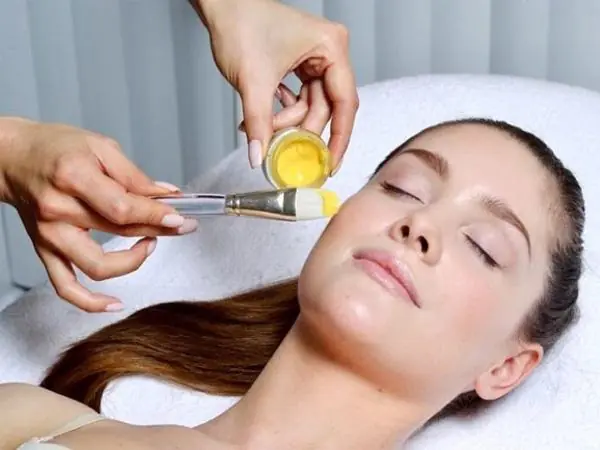
Retinoids, entering the tissue, stimulate the restoration of the epithelium. The production of collagen and elastin is accelerated, improving skin quality. Active growth of fresh cells is observed, which promotes rapid regeneration, restoration and rejuvenation of dermal structures. Local metabolic activity is noticeably activated, and the launch of protective mechanisms is provoked. Sebum secretion is normalized and the aging process is slowed down.
Ingredients for retinol peeling can be purchased at retail outlets specializing in professional cosmetics and pharmacies. Completely ready-to-use formulations and individual components are sold. The main required ingredient is retinoic acid (5–20% concentration). You can also use retinoic ointment. The component will cost 300–350 rubles. The procedure may also require: glycolic cream, salicylic acid. The ingredients can be purchased at any pharmacy.
The essence of the procedure
Retinoic peeling refers to chemical options for exfoliating the upper layer of skin. The procedure is performed by a cosmetologist or independently. The essence of the intervention is to soften and exfoliate the keratinized epidermis.
This allows you to cleanse and rejuvenate the skin. The anti-aging effect is achieved only after completing a course of procedures. After retinoic peeling, the skin is actively renewed.
Fresh fabrics have “young” characteristics: density, firmness, elasticity. Thanks to the exfoliating effect of the procedure, the depth of existing wrinkles decreases, and the formation of new ones occurs at a lower rate.
Indications for use

Retinoic peeling is carried out to improve the quality of skin that has been exposed to age (flabby, mature skin), prone to various imbalances (oily, dry type of epidermis, impaired functioning of the sebaceous glands, improperly organized care system).
The procedure helps cleanse the tissues; completing a course of retinoic effects leads to an anti-aging effect.
Cosmetologists say that retinoic peeling is useful in the following cases:
- the presence of comedones (blackheads with white, pink contents);
- acne beyond the purulent stage of development;
- increased (decreased) sebum secretion;
- the occurrence of hyperpigmentation;
- the effects of aging (impaired firmness, elasticity, tissue density);
- the appearance of wrinkles;
- post-acne, scars, stretch marks.
The procedure will help normalize the current condition and have a positive effect on the quality of the skin in the long term.
Attention! This option is suitable for those with epidermis with noticeable age-related changes (after 30–35 years), especially with the finely wrinkled type of aging.
Efficiency of the procedure
After retinoic peeling, the skin is cleansed, tightened, small expression wrinkles disappear, and the depth of large creases, folds, and scars decreases. The face looks young and fresh: tone and relief are evened out, signs of fatigue disappear. Metabolic processes are activated, which has a positive effect on the further improvement of achievements by the body.
To prevent various changes, retinoic peeling is carried out once every six months. This option is suitable for those who are prone to early aging and inflammatory processes. To achieve a bright effect of rejuvenation, cleansing, and smoothing the relief, a course of interventions is necessary. The procedure is carried out once a month at least 4–6 times. You can repeat the intensive course only after six months.
Preparatory stage
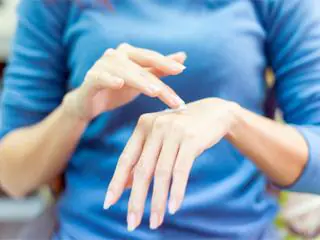
Before carrying out retinoic peeling, it is necessary to perform preparatory actions. One month before the procedure, you should stop tanning. Natural insolation and visiting a solarium are prohibited.
Approximately the same amount of time will be required to protect the skin from exposure to ultraviolet radiation after the intervention. Therefore, exposure is not recommended in the summer.
2 weeks before the procedure, any aggressive effects on the epidermis are excluded: cleansing masks, scrubs, hardware treatments. During this period, it is recommended to “introduce” the skin to the main active ingredient of retinoic peeling.
Carotenoids are found in many anti-aging products. You can make masks containing vitamin A twice a week. This will soften the epidermis and subsequently avoid negative reactions to peeling.
Before the session, it is important to do an allergy test of the composition: apply the product that is going to be used on the bend of the elbow. If negative reactions occur, the procedure is not performed on the face.
Carrying out the procedure
There are different options for preparing and performing retinoic peeling. To make the right choice, it is important to seriously assess the type and current condition of your skin. If in doubt, it is better to consult a cosmetologist for the procedure or at least consult a doctor.
Retinoic peeling at home is carried out in the following sequence:
- Preparation for execution. Before the procedure, it is advisable to collect your hair, avoiding it getting into your face, and put on comfortable clothes. The composition is applied to a face that has been previously cleansed of cosmetics, grease, and dust. For washing, use the usual product: milk, gel, foam. Additionally, it is recommended to treat the surface with a degreasing tonic.
- Preparation of the composition. To avoid negative consequences, it is recommended to use a ready-made composition, which can be purchased at a pharmacy or store. If you want to prepare the mixture yourself, you need to stock up on the necessary ingredients. The simplest option is a mixture of distilled water and retinoic acid. A glass or enamel container is filled with water (3 ml), acid is poured into it in the same amount. Mix everything and use it externally for its intended purpose.
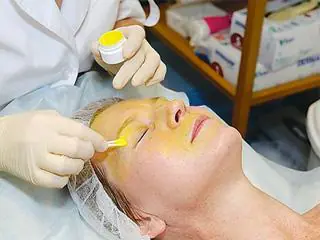
Performing peeling. Apply the prepared mixture with a cosmetic brush or hands wearing disposable gloves evenly on the face, neck, décolleté, avoiding the area of the eyes, lips, moles, and papillomas. The composition dries in 15–30 minutes. At this time, it is especially important to relax, not strain your facial muscles, and limit your facial expressions. Under the layer of composition, unpleasant sensations may occur: itching, burning, tightness. This is normal. If severe pain occurs, it is recommended to remove the substance immediately. Typically the peel is left to work for 4-10 hours. When becoming familiar with the procedure, it is recommended to remove the composition after 45–60 minutes.- Removing the composition. The dry mass must be neutralized, soaked, and washed off with water. For neutralization, use a weak alkaline solution (1 teaspoon of baking soda mixed with a glass of water at room temperature). A cotton pad soaked in the solution is carefully passed over the surface. The remaining substances are washed off with ordinary cool water.
- Hydration. After removing the composition, the skin is red and tight. It is necessary to moisturize well and protect the covers. To do this, use an intensive moisturizing cream (it is recommended to use a post-peeling care product or panthenol). The substance is applied in a thick layer and does not wash off.
Advice. To obtain the maximum cleansing effect, it is recommended to use a mixture of retinoic and salicylic acids in equal proportions, diluted with water.
For peeling, you can use retinoic ointment instead of acid. To do this, glycolic ointment is applied to the surface to soften and prepare. After 10–15 minutes, a glycol version is applied on top of it. The remaining steps of the procedure in the description of any recipe remain unchanged.
Photos before and after
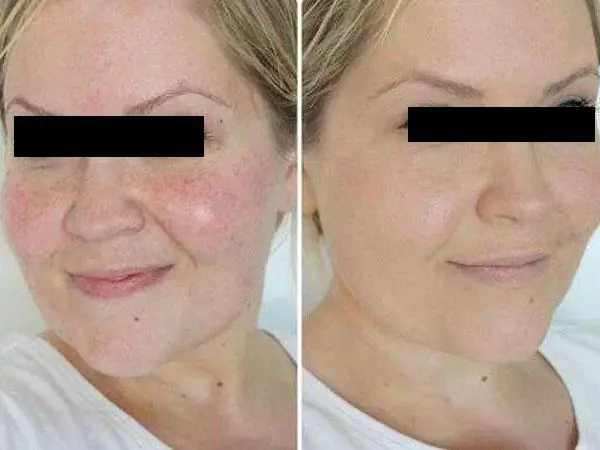

Recovery period
After the procedure, the skin is red, tight, and gradually turns yellow. When properly moisturized, the color of the skin approaches tanning. On days 3–8, active peeling of the upper layer of the epidermis begins. The skin comes off in whole layers or peels off gradually. You cannot interfere with the process: scratch or tear off the scabs.
The face continues to be lubricated with moisturizer. The process is repeated up to 2-3 times a day. When going outside, protect your covers from the sun with a high-level UV filter (from 30). It is unacceptable to be in direct sunlight or visit a solarium.
It is advisable to avoid baths, saunas, and washing in excessively hot water. It is recommended to postpone visiting the gym or swimming pool for 1–2 weeks. During the rehabilitation period, it is not recommended to consume alcohol, fatty, salty, spicy foods. It is important to establish a drinking balance: drink at least 2–3 liters of clean water per day. Tissue renewal will occur in 10–14 days.
The result of the procedure is noticeable after the restoration of the integument: the skin is smoothed and cleansed. To achieve maximum rejuvenating effect, a course of 4–6 interventions is required. Sessions are carried out once every 3-4 weeks.
Attention! The result lasts for at least 6 months. Cosmetologists recommend conducting courses once every six months: in autumn and spring.
Precautionary measures

Retinoic peeling is not performed during pregnancy, at the stage of planning conception in the period 3–6 months after the procedure. The effect of carotenoids affects the gestation of the fetus and the proper formation of the baby’s systems. The intervention is also not carried out if:
- liver diseases, complex kidney pathologies;
- diseases of the circulatory system;
- individual intolerance to components;
- open wounds of the integument;
- sensitive skin;
- herpes, eczema, psoriasis, other active rashes;
- oncology;
- purulent inflammation;
- mental disorders.
The option of aesthetic correction is also excluded during lactation, active disease, and poor health.
After peeling, various side effects may occur:
- temperature increase;
- spread of burns, spots;
- the appearance of itching, burning, pain;
- formation of edema.
Complications can be avoided by preliminary testing for allergies, performing all actions according to the instructions, and proper subsequent care. Redness, excessive peeling, and mild discomfort are not paid attention to. These are normal reactions of the body.
Advantages and disadvantages
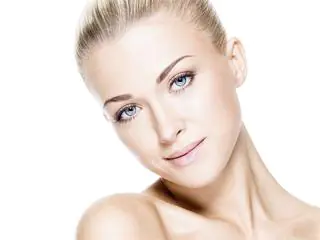
A clear advantage of the retinoic exfoliation option is the effective result. The technique is actively used by cosmetologists and gives the option positive marks. The method gives a noticeable rejuvenating effect.
The disadvantages of retinoic peeling are:
- the need for lengthy training;
- long procedure, recovery;
- seasonal dependence;
- high probability of complications;
- dependence of the result on compliance with the rules of conduct.
Important point! Cosmetologists do not recommend experimenting with the technique at home. This warning is not aimed at attracting clients, but at eliminating negative results that form an opinion about the correction method.
Opinion of cosmetologists
Doctors love to work with yellow peeling. Working with the substance requires a professional approach, but when used correctly, it gives bright positive results. Positive evaluations from patients form the reputation of a cosmetologist.
The cosmetologist likes the option, but there are nuances in obtaining the expected result.

The cosmetologist is ambivalent about the option, there are many nuances for the appointment.
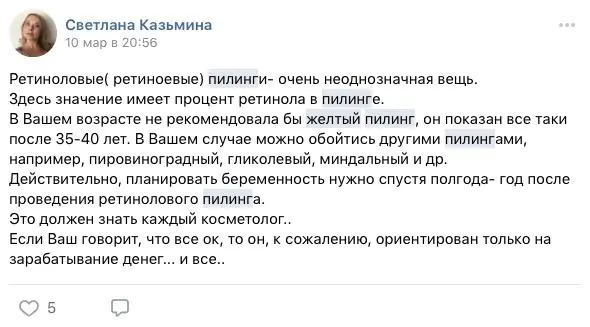
The cosmetologist is selective in his prescription.

Patient reviews
Yellow peeling is actively used by patients. Independent procedures are carried out, clients turn to cosmetologists to perform them. The results of the composition's work cause positive and negative assessments.
The result of exposure is spots on the skin.

Positive impression of the result.
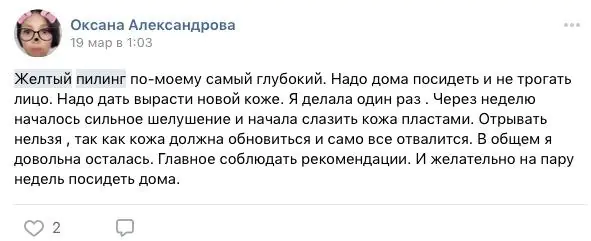
The expected result was not obtained.

Useful videos
Retinoic peeling. We prepare, apply and look at the results.

Many specialized salons offer this procedure, but you can do it yourself at home.
Forms of release and composition of the product
The drug is available as an ointment in tubes of 10, 15, 20 and 35 grams, as well as in different concentrations of isotretinoin - 0.05% and 0.1%. The product is based on the most effective form of vitamin A, supplemented by other ingredients.
Beneficial features
The peeling procedure with retinoic ointment is good not only because of its accessibility and simplicity. The drug is designed directly to combat skin rashes, but its composition allows you to get rid of other dermatological problems, including reducing wrinkles.
Thanks to retinoic ointment, you can achieve the following effects:
- improved skin renewal;
- activation of collagen synthesis;
- smoothing wrinkles;
- giving the skin softness and elasticity;
- restoration and strengthening of damaged areas of the epidermis;
- getting rid of age spots;
- exfoliation of dead skin cells.
Peeling with retinoic ointment starts the process of skin restoration, evens out its surface, and prevents the occurrence of unwanted pigmentation. This product is actively used by dermatologists and cosmetologists to create masks, as it has no serious side effects. As a result of the procedure, the face is cleansed and looks younger and fresher.
Contraindications for use
Retinoic ointment, like any other pharmaceutical product, has a number of contraindications, including:
- excessive oily skin;
- individual sensitivity;
- liver dysfunction;
- pregnancy and lactation;
- hypervitaminosis;
- taking medications, including antibiotics.
- peeling and irritation of the skin;
- greasy shine, appearance of comedones;
- excessive dry skin;
- mood swings, depression;
- headaches, increased intracranial pressure.
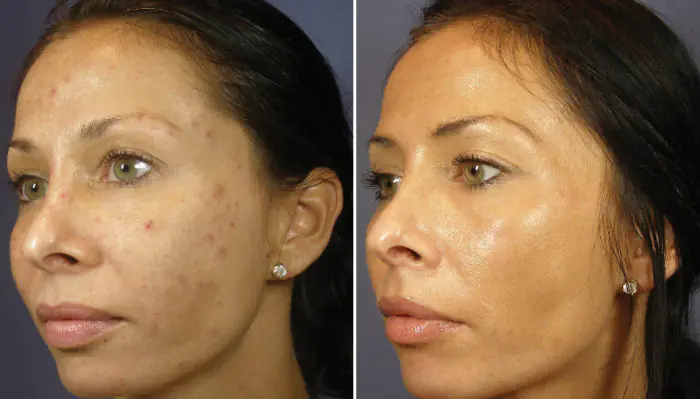
Cost of ointment
Retinoic ointment is a cosmetic product, so you can buy it without a prescription. Depending on the pharmacy chosen and the volume of the tube, the price ranges from 150 to 300 rubles per package.
Features of retinoic peeling
To carry out such peeling, you need not only ointment, but also fruit acids. In cosmetology, they are used to regenerate and restore the epidermis, get rid of dead skin cells and age spots. Thanks to a mask with this composition, the skin does not dehydrate, and the body starts producing its own collagen. Using retinoic ointment, you can smooth out wrinkles in the skin and make it more elastic.
Fruit acids are most often used by women aged 35-55 years, and the ointment has an antiseptic effect. The finished mask can be applied not only to the face and neck, but also to the décolleté, arms and legs. To achieve the best effect, a set of four procedures should be performed. The course does not need to be repeated very often - only once every six months. Thanks to numerous positive reviews, you can evaluate the effectiveness of the procedure, and with the help of ready-made recipes, you can easily use the product at home.
Indications
Quite safe and gentle peeling is recommended for:
- the formation of acne, acne, pigmentation and other rashes on the face;
- the appearance of the first wrinkles;
- decreased skin elasticity;
- the appearance of scars after acne (post-acne).
Features of peeling with retinoic ointment
The mask should be applied to the entire face and décolleté. After the procedure, slight redness of the skin may occur, which will quickly subside.
The mask is based on retinoic ointment, which can be mixed with aloe juice, various herbal decoctions, vegetable and herbal mixtures, and natural oils.
Retinoic ointment, if necessary, can be replaced with Tretinoin, Differin or azelaic acid, which are also freely sold in any pharmacies. Experts recommend using the same sequence of actions that is used in salon sessions. At home, peeling is performed as follows:
- no types of scrubs are used as preparation for two weeks before the procedure;
- the face is thoroughly cleansed;
- Glycolic acid is applied to the skin;
- after it is absorbed, retinoic ointment is applied in a thin layer;
- after 45 minutes, a neutral mixture is applied to the skin;
- the mask should be left for 7 hours and then washed off with warm water.
After the procedure, there is usually a feeling of peeling, which is a clear indicator that the composition used is working.
Homemade peeling with retinoic ointment: homemade recipes
The people's treasury of knowledge contains several easy-to-use recipes. Peeling is carried out strictly in stages.
- First, glycolic acid is applied to the skin. Then you should mix retinoic ointment with vitamin E in equal proportions and cover the skin with the resulting mixture for 20 minutes. Then a neutral agent is applied and the mask is left for another 5-7 hours, after which it should be washed off with warm water.
- As a vitamin mass, you can use retinoic ointment mixed with aloe juice in equal parts. This product is applied to the skin for one hour, and then a neutral component is used.
Another option for the vitamin mass includes retinoic ointment, almond oil and burdock oil taken in equal proportions. This composition is also applied for one hour.
Skin restoration after peeling
After using a delicate and safe peeling, it would be logical to expect the effect of soft and velvety skin, but this is not entirely true. After some time - from 12 hours to a day - the skin begins to actively peel off. In this way, dead, keratinized cells are removed. Redness of the skin may also appear, which disappears on the second to fourth day after the procedure.
Complete skin renewal occurs in 7 days, and the maximum effect manifests itself only on 21 days. This amount of time is required for complete renewal and restoration of skin cells. Typically, during this period, 3-4 peeling procedures with retinoic ointment are performed.
The process of exfoliation of the skin is very intense, so it is recommended to take maximum care in your skin care and daily life. Do not touch your face with your hands or use scrubbing or aggressive products. To cleanse the skin during this period, you should not use tonics, but warm water. It is useful to apply neutral moisturizers with UV protection and use enzyme masks.
Since after using retinoic ointment the skin becomes more susceptible to ultraviolet radiation, it is best to carry out the procedure in autumn or spring. This will minimize the risk of sunburn and also choose a convenient schedule for repeated sessions.



